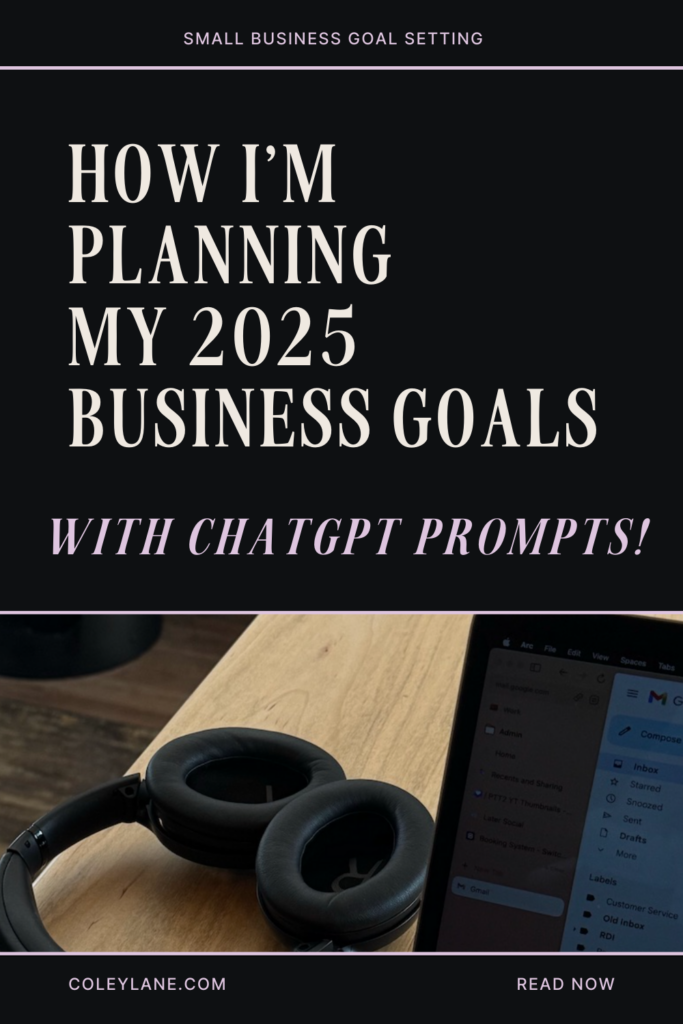No because maybe this is just me but I always set goals for my business, but don’t get to the point where I have an in-depth plan that I’m confident about. That’s exactly why I decided to use ChatGPT to map out my 2025 business goals, and let me tell you, it changed the game.
I’ve never felt so prepared going into the new year!
I’ve tried spreadsheets and templates, but they hadn’t worked because it felt too overwhelming to fully plan out everything from revenue goals to mapping out an executable strategy. It takes a lot of steps out of the process.
I asked it to break down my income goals, map out quarterly plans, and even help me brainstorm new offers without completely overhauling what’s already working. I’m actually so obsessed with this process and wanted to show you how you could do the same.
Whether you’re ready to hit six figures (or seven), streamline your services, or add passive income without burning out, this step-by-step guide will show you exactly how to set up your 2025 business goals with ChatGPT and actually stick to them.
I’ve sprinkled in some in-depth prompts for each step that you can use to get the best results within the platform.
I always think of prompting as a conversation – it’s not going to be perfect on the first go around, but after you keep chatting you should get some really valuable help for your 2025 business goals. Let’s dive in!

Steps to Planning my 2025 Business Goals with ChatGPT
Step 1: Assess Last Year’s Results
Before you map out where you’re going, you need to know where you’ve been. Grab a notebook (or open your Notes app) and take stock of what worked and what flopped.
What offers brought in the most revenue? Where did your clients or sales come from: Instagram, Pinterest, email, referrals? What tasks or projects felt heavy and stressful versus easy and fun?
Your goal here is to identify patterns. If a service consistently brought in cash but drained your energy, can you raise prices or tweak the delivery? If Pinterest quietly sent leads while Instagram required constant effort, maybe it’s time to double down on what’s working.
When I did this as a Pinterest Manager, I realized that a lot of clients have come through referrals this year more than ever, so building a referral program would make sense going forward. And noticed that Instagram and email are big opportunity areas I can dive into more in 2025.
ChatGPT Prompt to Try:
“Analyze my business performance from last year based on revenue. I made $[total revenue] through [list revenue streams, e.g., services, products, affiliate income]. My top-earning offer was [name offer] at $[amount] with a [profit margin %] profit margin. My second-highest income source was [name offer] at $[amount] with a [profit margin %] profit margin. I spent approximately [X hours] per week on [main tasks] to deliver these offers. Based on this information, what should I prioritize, tweak, or drop to improve profitability and reduce effort?” It may also be helpful to add in some screenshots.
Step 2: Map Out Your Revenue Goals
Now let’s talk numbers. Start with your dream revenue goal, whether that’s $50k, $100k, or $500k, and work backward to figure out what it’ll take to hit that.
Break down your income streams. Think core services, digital products, passive income, and upsells. Decide how much revenue each stream needs to bring in.
Calculate how many sales or clients you need per month to reach that goal. For example, if your goal is $120k and you’re offering a $500/month service, you’d need 20 clients on a 6-month contract—or a mix of services and products to balance income.
I did this by setting my annual goal first, then reverse-engineering it to figure out how many clients I need to book each quarter and how many lower-priced products I needed to sell in between.
ChatGPT Prompt to Try:
“I want to make $[total revenue goal] this year. Help me break it down into monthly and quarterly revenue goals, including how many sales I need to make for each product or service. I currently offer [product/service 1] priced at $[price] and [product/service 2] priced at $[price]. I also plan to introduce [new product/service idea, if any] priced at $[price] by [timeline, e.g., Q2]. Include suggestions for bundling, upsells, or seasonal promotions to help me hit my targets, as well as strategies for balancing income from high-ticket services and lower-cost products.”
Step 3: Break Goals Into Quarterly Plans
Big goals are great, but let’s not set ourselves up for burnout. Breaking goals into 90-day plans keeps things realistic and gives you flexibility to pivot if something isn’t working.
Focus each quarter on a specific priority.
Q1: Build momentum—refresh offers, set up systems, and plan launches.
Q2: Launch new offers and test marketing strategies.
Q3: Scale—hire support, optimize funnels, or create passive income streams.
Q4: Focus on profits—holiday promos, bundles, and finishing the year strong.
Each quarter, map out what offers you’re selling, what marketing strategies you’re testing, and key deadlines (launches, promotions, and email campaigns).
I planned my quarters by assigning each one a theme: Q1 is all about setup and recurring revenue, Q2 is launch season, Q3 focuses on scaling my offers, and Q4 is about squeezing the most out of holiday sales.
ChatGPT Prompt to Try:
“Create a detailed quarterly business plan focused on revenue growth for my [type of business, e.g., service-based or product-based business]. Break it down into four quarters, each with one primary focus aligned to scaling revenue. Include specific tasks I should prioritize each month to support that focus, such as launching offers, building funnels, optimizing marketing strategies, or improving client retention. Also, provide suggestions for tracking progress, measuring results, and adjusting strategies if something isn’t working.“

Step 4: Plan to Adjust and Tweak
Business plans are not written in stone. Plan to adjust them if needed, and if you’re like me, that’s the hardest part about having a roadmap for the year. I may change my mind or I may decide that what I’m doing isn’t working or making me happy.
I always say, adjust your strategy not your goal, because the goal should be firm that you set, e.g. an income goal. But there are several ways you can accomplish that, so don’t be afraid to pivot.
Realized one income stream is outperforming the others? Shift more energy there. It’s not about scrapping the plan; it’s about making small shifts that keep you on track without losing momentum.
I reviewed my numbers at the end of each month and used that data to decide if I needed to adjust my pricing, focus more on ads, or put extra energy into my evergreen funnels.
ChatGPT Prompt to Try:
“Review my current business performance and suggest adjustments to keep me on track with my revenue goals while minimizing burnout. I’ve made $[current revenue] so far, with [X sales of product/service] and [X sales of product/service] at [list prices]. My original focus was on [specific goal, e.g., launching a course, growing email subscribers, or scaling services], but I’m noticing [specific challenge, e.g., slower sales, burnout, or shifting priorities]. Based on these results, recommend small but impactful tweaks I can make—like adjusting pricing, simplifying offers, focusing more on high-performing income streams, testing ads, or outsourcing tasks—to stay aligned with my goals without starting over.”
Step 5: Add New Offers, Sustainably
Adding new products or services can feel exciting, but let’s make sure you’re not accidentally building a house of cards. Start with what you already know—could you turn client work into templates or toolkits?
Test the waters with low-lift digital products before committing to big launches. Use seasonal launches to avoid constant promotion cycles (hello, sanity).
And don’t forget evergreen funnels! Once an offer is dialed in, automate it so it keeps selling while you’re working on the next big thing. I started by creating a $47 toolkit and used it to test my audience’s interest before turning it into a bigger challenge and eventually an evergreen funnel.
ChatGPT Prompt to Try:
“I want to add a new income stream to my business, such as [digital products, courses, or memberships], to complement my existing offers. My target audience is [describe audience—e.g., small business owners, couples seeking financial help, etc.], and their biggest challenges are [list challenges, e.g., marketing overwhelm, lack of leads, etc.]. I need a detailed, step-by-step plan to create, launch, and turn this offer into an evergreen funnel.
Break this down into the following phases:
- Product Development: Outline how to validate my idea, structure the content, and price it based on value and competitor research.
- Pre-Launch: Provide strategies for warming up my audience, building a waitlist, and creating buzz on platforms like [Pinterest, Instagram, or email marketing].
- Launch Strategy: Suggest a launch timeline, including email sequences, sales page tips, and promotional content ideas that convert.
- Evergreen Funnel Setup: Walk me through automating sales using email sequences, lead magnets, and paid ads, while recommending tools to simplify the process.
- Optimization: Provide tips for tracking performance, A/B testing, and tweaking the funnel to improve conversions over time.
Make sure the plan includes specific examples of [high-converting lead magnets, email subject lines, and upsells] I can use to maximize revenue. Also, recommend any tools or platforms I should use to streamline the process.”

Step 6: Track Progress Without Obsessing
Now that you’ve got your plan, don’t just set it and forget it. Review your progress monthly to see what’s working, what’s not, and what needs tweaking.
Focus on revenue goals vs. actual results, traffic and leads—what’s driving them, and marketing efforts—what’s converting. And celebrate the wins (even the small ones).
I used ChatGPT to create a check-in template for monthly progress tracking and made it part of my routine to review analytics over coffee on the first Monday of every month.
ChatGPT Prompt to Try (using Canvas):
“Create a monthly check-in template for tracking progress on revenue, sales, and leads, plus space to brainstorm tweaks or pivots if needed.”
Bonus Prompts for Refining Your Plan:
ChatGPT Prompt for Marketing Channels
“Based on my target audience of [describe audience – e.g., wedding professionals, diy enthusiasts, etc.], which marketing channels are most effective for attracting leads and driving conversions? Include data-backed suggestions for platforms like Instagram, Pinterest, TikTok, and email marketing. Also, recommend strategies for [organic growth, paid ads, and partnerships] specific to my niche.”
ChatGPT Prompt for Content Repurposing
“I have a library of blog posts, Instagram captions, and Pinterest pins focused on [specific topic, e.g., wedding planning, digital marketing tips, etc.]. Can you create a detailed repurposing plan to transform this content into new formats like Reels, carousels, email sequences, lead magnets, or webinars? Include tips for optimizing SEO, headlines, and calls-to-action to attract more leads and drive sales.” (Note: Include screenshots of your favorite posts as examples!)
ChatGPT Prompt for Email List Growth
“I’m targeting [specific audience] and want to grow my email list quickly. Can you suggest a step-by-step strategy for list-building that includes lead magnets, landing pages, social media promotions, collaborations, and ads? Include specific examples of high-converting lead magnets, email opt-in forms, and subject lines tailored to my audience’s pain points and goals.”
ChatGPT Prompt for Email Nurture Sequence
“Write a 5-email nurture sequence designed to promote my [specific product or service] to [specific audience]. The sequence should build trust, highlight pain points, offer solutions, and create urgency without feeling pushy. Include engaging subject lines, personalization tips, and strong calls-to-action that guide readers from sign-up to purchase. Also, add a bonus email idea for re-engaging subscribers who don’t convert right away.”
ChatGPT Prompt for Workflows
“I run a [type of business—e.g., wedding planning, digital marketing, coaching, etc.] and need to streamline my workflows. Can you recommend tools and systems for project management, client onboarding, email marketing, social media scheduling, and content creation? Include both free and paid options, along with pros, cons, and use cases for each.”
Planning your business goals with ChatGPT can make the process of goal setting so much easier. Start with the big picture (revenue goals), break it down into quarterly plans, and stay flexible enough to make adjustments along the way.
Use ChatGPT to brainstorm ideas, write funnels, and organize your strategies so you can focus on scaling without burning out. Now lets put these ChatGPT prompts to use!
Pin this:








Comments +